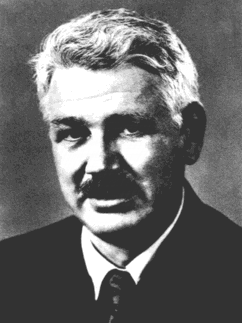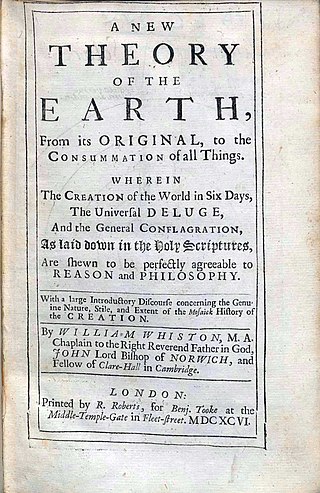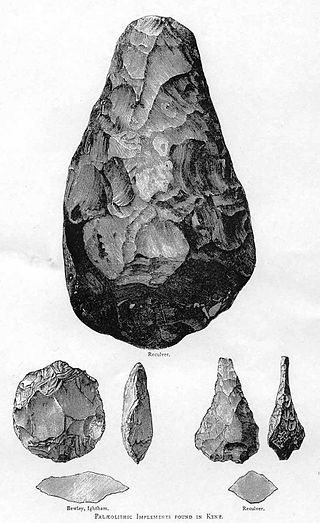Related Research Articles

Creationism is the religious belief that nature, and aspects such as the universe, Earth, life, and humans, originated with supernatural acts of divine creation. In its broadest sense, creationism includes a continuum of religious views, which vary in their acceptance or rejection of scientific explanations such as evolution that describe the origin and development of natural phenomena.

Carleton Stevens Coon was an American anthropologist. A professor of anthropology at the University of Pennsylvania, lecturer and professor at Harvard University, he was president of the American Association of Physical Anthropologists. Coon's theories on race were widely disputed in his lifetime and are considered pseudoscientific in modern anthropology.
Charles Hutchins Hapgood was an American college professor and author who became one of the best known advocates of the pseudo-scientific claim of a rapid and recent pole shift with catastrophic results.

Noah's Ark is the ship in the Genesis flood narrative through which God spares Noah, his family, and examples of all the world's animals from a global deluge. The story in Genesis is based on earlier flood myths originating in Mesopotamia, and is repeated, with variations, in the Quran, where the Ark appears as Safinat Nūḥ and al-fulk. The myth of the global flood that destroys all life begins to appear in the Old Babylonian Empire period. The version closest to the biblical story of Noah, as well as its most likely source, is that of Utnapishtim in the Epic of Gilgamesh.
Pseudoarchaeology—also known as alternative archaeology, fringe archaeology, fantastic archaeology, cult archaeology, and spooky archaeology—is the interpretation of the past by people who are not professional archaeologists and who reject or ignore the accepted data gathering and analytical methods of the discipline. These pseudoscientific interpretations involve the use of artifacts, sites or materials to construct scientifically insubstantial theories to strengthen the pseudoarchaeologists' claims. Methods include exaggeration of evidence, dramatic or romanticized conclusions, use of fallacious arguments, and fabrication of evidence.

Ancient astronauts refer to a pseudoscientific set of beliefs which holds that intelligent extraterrestrial beings visited Earth and made contact with humans in antiquity and prehistoric times. Proponents suggest that this contact influenced the development of modern cultures, technologies, religions, and human biology. A common position is that deities from most, if not all, religions are extraterrestrial in origin, and that advanced technologies brought to Earth by ancient astronauts were interpreted as evidence of divine status by early humans.

Young Earth creationism (YEC) is a form of creationism which holds as a central tenet that the Earth and its lifeforms were created by supernatural acts of the Abrahamic God between about 6,000 and 10,000 years ago. In its most widespread version, YEC is based on the religious belief in the inerrancy of certain literal interpretations of the Book of Genesis. Its primary adherents are Christians and Jews who believe that God created the Earth in six literal days. This is in contrast with old Earth creationism (OEC), which holds literal interpretations of Genesis that are compatible with the scientifically determined ages of the Earth and universe. It is also in contrast to theistic evolution, which posits that the scientific principles of evolution, the Big Bang, abiogenesis, solar nebular theory, age of the universe, and age of Earth are compatible with a metaphorical interpretation of the Genesis creation account.

Graham Bruce Hancock is a British writer who promotes pseudoscientific theories involving ancient civilizations and hypothetical lost lands. Hancock speculates that an advanced ice age civilization was destroyed in a cataclysm, but that its survivors passed on their knowledge to hunter-gatherers, giving rise to the earliest known civilizations of ancient Egypt, Mesopotamia, and Mesoamerica.

A flood myth or a deluge myth is a myth in which a great flood, usually sent by a deity or deities, destroys civilization, often in an act of divine retribution. Parallels are often drawn between the flood waters of these myths and the primaeval waters which appear in certain creation myths, as the flood waters are described as a measure for the cleansing of humanity, in preparation for rebirth. Most flood myths also contain a culture hero, who "represents the human craving for life".

Nicolas Camille Flammarion FRAS was a French astronomer and author. He was a prolific author of more than fifty titles, including popular science works about astronomy, several notable early science fiction novels, and works on psychical research and related topics. He also published the magazine L'Astronomie, starting in 1882. He maintained a private observatory at Juvisy-sur-Orge, France.

Frauds, Myths, and Mysteries: Science and Pseudoscience in Archaeology is a book by Kenneth L. Feder on the topic of pseudoarchaeology. Feder is an emeritus professor of archaeology at Central Connecticut State University.

The pre-Adamite hypothesis or pre-Adamism is the theological belief that humans existed before the biblical character Adam. Pre-Adamism is therefore distinct from the conventional Abrahamic belief that Adam was the first human. "Pre-Adamite" is used as a term, both for those humans believed to exist before Adam, and for believers or proponents of this hypothesis.

A New Theory of the Earth is a book written by William Whiston, in which he presents a description of the divine creation of the Earth and a posited global flood. He also postulates that the earth originated from the atmosphere of a comet and that all major changes in earth's history can be attributed to the action of comets. It was published in 1696 and was well received by intellectuals of the day such as Isaac Newton and John Locke.
Polygenism is a theory of human origins which posits the view that the human races are of different origins (polygenesis). This view is opposite to the idea of monogenism, which posits a single origin of humanity. Modern scientific views find little merit in any polygenic model due to an increased understanding of speciation in a human context, with the monogenic "Out of Africa" hypothesis and its variants being the most widely accepted models for human origins. Polygenism has historically been heavily used in service of white supremacist ideas and practices, denying a common origin between European and non-European peoples. It can be distinguished between Biblical polygenism, describing a Pre-Adamite or Co-Adamite origin of certain races in the context of the Genesis narrative of Adam and Eve, and scientific polygenism, attempting to find a taxonomic basis for ideas of racial science.

Prehistory, also called pre-literary history, is the period of human history between the first known use of stone tools by hominins c. 3.3 million years ago and the beginning of recorded history with the invention of writing systems. The use of symbols, marks, and images appears very early among humans, but the earliest known writing systems appeared c. 5,200 years ago. It took thousands of years for writing systems to be widely adopted, with writing spreading to almost all cultures by the 19th century. The end of prehistory therefore came at different times in different places, and the term is less often used in discussing societies where prehistory ended relatively recently.

Psychic archaeology is a loose collection of practices involving the application of paranormal phenomena to problems in archaeology. It is not considered part of mainstream archaeology, or taught in academic institutions. It is difficult to test scientifically, since archaeological sites are relatively abundant, and all of its verified predictions could have been made via educated guesses.
The discovery of human antiquity was a major achievement of science in the middle of the 19th century, and the foundation of scientific paleoanthropology. The antiquity of man, human antiquity, or in simpler language the age of the human race, are names given to the series of scientific debates it involved, which with modifications continue in the 21st century. These debates have clarified and given scientific evidence, from a number of disciplines, towards solving the basic question of dating the first human being.

The following outline is provided as an overview of and topical guide to prehistoric technology.
Although biological evolution has been vocally opposed by some religious groups, many other groups accept the scientific position, sometimes with additions to allow for theological considerations. The positions of such groups are described by terms including "theistic evolution", "theistic evolutionism" or "evolutionary creation". Of all the religious groups included on the chart, Buddhists are the most accepting of evolution. Theistic evolutionists believe that there is a God, that God is the creator of the material universe and all life within, and that biological evolution is a natural process within that creation. Evolution, according to this view, is simply a tool that God employed to develop human life. According to the American Scientific Affiliation, a Christian organization of scientists:
A theory of theistic evolution (TE) — also called evolutionary creation — proposes that God's method of creation was to cleverly design a universe in which everything would naturally evolve. Usually the "evolution" in "theistic evolution" means Total Evolution — astronomical evolution and geological evolution plus chemical evolution and biological evolution — but it can refer only to biological evolution.

Magicians of the Gods: The Forgotten Wisdom of Earth's Lost Civilisation is a 2015 book by British pseudoarchaeology writer Graham Hancock, published by Thomas Dunne Books in the United States and by Coronet in the United Kingdom. Macmillan Publishers released an "updated and expanded" paperback edition in 2017.
References
- ↑ Fagan, Brian. (1981). American Genesis? Review of American Genesis by Jeffrey Goodman. Early Man 3(4): 24-26.
- ↑ Stanford, Dennis. (1981). Who's on First? Review of American Genesis by Jeffrey Goodman. Science '81 June. pp. 91-92.
- ↑ Turner, Christy G. (1981). Review of American Genesis: The American Indian and the Origins of Modern Man by Jeffrey Goodman. Archaeology 35: 72-74.
- ↑ Feder, Kenneth L. (1983). American Disingenuous: A Critique of Dr. Jeffrey Goodman's American Genesis. The Skeptical Inquirer 7(4): 36-48.
- 1 2 Charpentier, Julia Ann, “The Comets of God: New Scientific Evidence for God,” ForeWord Reviews, January 6, 2011
- ↑ Book Review of The Comets of God
- ↑ quoted in Feder, Kenneth L. Encyclopedia of Dubious Archaeology:From Atlantis to the Walam Olum, Greenwood, 2010, ISBN 978-0-313-37918-5 pp.7-8
- ↑ Baskin, Yvonne, “Cro-Magnon Roots Theorized- Modern Man Born In America?” The San Diego Union, March 2, 1981 >
- ↑ Dean, Paul, “Unorthodox Scientist-Going Out on a Limb on the Origins of Man,” Los Angeles Times, February 23, 1981, View, Part V, pp. 1-2, >
- ↑ Long, Joseph, K., editor, Extrasensory Ecology: Parapsychology and Anthropology, Scarecrow Press, Inc. Metuchen, NJ & London, 1977, ISBN 0-8108-1036-0, pp. 313-314>
- ↑ Williams, Stephen. "Psychic Archaeology." Fantastic Archaeology: the Wild Side of North American Prehistory. University of Pennsylvania Press, Philadelphia,1991,p.301>
- ↑ Kenneth Feder (1986). "American Disingenuous: Goodman's 'American Genesis'— A New Chapter in 'Cult' Archaeology". In Frazier, Kendrick (ed.). Science Confronts the Paranormal. Prometheus Books. p. 281. ISBN 978-0879753146.
- 1 2 3 4 Williams, Stephen. "Psychic Archaeology." Fantastic Archaeology: the Wild Side of North American Prehistory. Philadelphia: University of Pennsylvania, 1991.
- ↑ South America, Volume 1, edited by Fritz Salomon, Stuart B. Schwartz, 1999, p. 196
- ↑ Human evolution: a guide to the debates, Brian Regal, 2004, p. 170
- ↑ The natural history of Creation: Biblical evolutionism and the return of natural theology, Michael Anthony Corey, 1995, p. 91
- ↑ The Skeptic encyclopedia of pseudoscience, Volume 1, Michael Shermer, 2002, p. 560
- ↑ Knots in a string: an introduction to native studies in Canada, Peggy Brizinski, 1989, p. 33
- 1 2 Cole, John R. Reviewed work(s): The Genesis Mystery: A Startling New Theory of Outside Intervention in the Development of Modern Man by Jeffrey Goodman. American Antiquity. Vol. 50, No. 3 (Jul., 1985), pp. 692-693. Published by: Society for American Archaeology.
- ↑ Reviewed work(s): American Genesis: The American Indian and the Origins of Modern Man by Jeffrey Goodman. American Indian Quarterly. Vol. 5, No. 4 (Nov., 1979), pp. 380-381. Published by: University of Nebraska Press